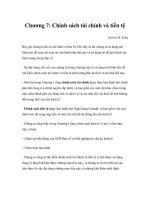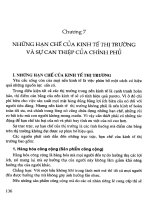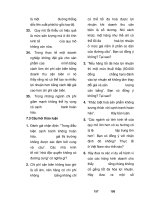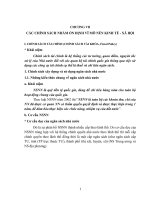Kinh tế vĩ mô Chap 7
Bạn đang xem bản rút gọn của tài liệu. Xem và tải ngay bản đầy đủ của tài liệu tại đây (1.71 MB, 37 trang )
Chapter 7 Aggregate expenditure and fiscal policy
Mentor Pham Xuan Truong
Content
I Aggregate expenditure model (Keynesian cross point model)
1 Introduction to aggregate expenditure model
2 Mathematical form of aggregate expenditure model
3 Aggregate expenditure model and aggregate demand
II Fiscal policy
1 What is fiscal policy
2 Effects of fiscal policy on the economy
3 Fiscal policy and government budget
Personal and marital life of Keynes
● Born
at 6 Harvey Road, Cambridge, John Maynard Keynes was the son of John
Neville Keynes, an economics lecturer at Cambridge University, and Florence Ada
Brown, a successful author and a social reformist. His younger brother Geoffrey
Keynes (1887–1982) was a surgeon and bibliophile and his younger sister Margaret
(1890–1974) married the Nobel-prize-winning physiologist Archibald Hill. Keynes
was very tall at 1.98 m (6 ft 6 in).
● In
1918, Keynes met Lydia Lopokova, a well-known Russian ballerina, and they
married in 1925. By most accounts, the marriage was a happy one. Before meeting
Lopokova, Keynes's love interests had been men, including a relationship with the
artist Duncan Grant and with the writer Lytton Strachey. For medical reasons,
Keynes and Lopokova were unable to have children, though both his siblings had
children of note
I Aggregate expenditure model (Keynesian cross point model)
1 Introduction to aggregate expenditure model
Main idea
The Great Depression caused many economists to question the validity of classical
economic theory They believed they needed a new model to explain such a pervasive
economic downturn and to suggest that government policies might ease some of the
economic hardship that society was experiencing.
In 1936, John Maynard Keynes wrote The General Theory of Employment, Interest and
Money. In it, he proposed a new way to analyze the economy, which he presented as an
alternative to the classical theory. Keynes proposed that low aggregate demand is
responsible for the low income and high unemployment that characterize
economic downturns. He criticized the notion that aggregate supply alone
determines national income.
I Aggregate expenditure model (Keynesian cross point model)
1 Introduction to aggregate expenditure model
Main idea
In the General Theory of Money, Interest and Employment, Keynes proposed
that an economy’s total income was, in the short run, determined
largely by the desire to spend by households, firms and the
government (i.e. aggregate demand). The more people want to spend,
the more goods and services firms can sell. The more firms can sell, the more
output they will choose to produce and the more workers they will choose to
hire.
Thus, the problem during recessions and depressions, according to
Keynes, was inadequate spending.
model this insight.
The Keynesian cross is an attempt to
I Aggregate expenditure model (Keynesian cross point model)
1 Introduction to aggregate expenditure model
Other assumptions
+ Prices, Wages and Interest Rate are Constant: this implies the rigidity of
specific market due to objective reasons
+ The Economy Operates at less than full Employment: this implies that firms
are willing to supply any amount of the good at a given price P. In other words,
assume that the supply of goods is completely elastic at price P. This
assumption is generally valid only in the short run
I Aggregate expenditure model (Keynesian cross point model)
1 Introduction to aggregate expenditure model
Main idea illustrated by AD – AS model
Price Level, P
SRAS
AD''
AD'
AD
Y*
Y*'
Y*''
Income, Output, Y
Compare to the idea of classical economists (2 special cases of AD – AS which imply
behavior of the economy in (very) short run and long run)
I Aggregate expenditure model (Keynesian cross point model)
1 Introduction to aggregate expenditure model
Building model
The aggregate expenditure model which is illustrated by vertical axis of
expenditure variable and horizontal axis of income (i.e. output)
variable has two lines
+ Actual expenditure: is the amount households, firms , the government and
foreigner spend on goods and services (GDP).
+ Planned expenditure (or APE – aggregate planned expenditure) is the
amount households, firms, the government and the foreigner would like to
spend on goods and services
I Aggregate expenditure model (Keynesian cross point model)
1 Introduction to aggregate expenditure model
Building model
Planned expenditure, APE
Actual Expenditure, Y=APE
Planned Expenditure,
APE = C + I + G + NX
Y2
Y*
Y1
Income, Output, Y
The economy is in equilibrium when: Actual Expenditure = Planned Expenditure
(Y=APE) or total income = planned expenditure
I Aggregate expenditure model (Keynesian cross point model)
1 Introduction to aggregate expenditure model
Building model
+ Actual expenditure is the 45 degree line, which implies the most important identity in
the macroeconomics Total income = Total expenditure (this is also indicated by
computing GDP in two ways but having the same result)
+ Planned expenditure has 3 properties
* Upward sloping: expenditure is planned to increase as income increase
* Positive intercept with vertical axis: when income is zero, the economy still plans to
expenditure for necessaries. This level of expenditure is called autonomous expenditure
(the lowest expenditure of the economy, the part of expenditure does not change as
income rises)
* Angular coefficient: has value between 0 and 1. It indicate normal behavior of economic
entity. When you have additional income, you will save more and consume more from it
I Aggregate expenditure model (Keynesian cross point model)
1 Introduction to aggregate expenditure model
Building model
How does the economy get to this equilibrium? Inventories play an important role in
the adjustment process. Whenever the economy is not in equilibrium, firms
experience unplanned changes in inventories, and this induces them to change
production levels. Changes in production in turn influence total income and
expenditure, moving the economy toward equilibrium.
+ if actual expenditure > planned expenditure: unplanned inventory increases →
firms decrease production
+ if actual expenditure < planned expenditure: unplanned inventory decreases →
firms increase production
1 Introduction to aggregate expenditure model
(Keynesian cross point model)
Expenditure multiplier (by graph)
Consider how changes in government purchases affect the economy. Because government purchases are one
component of expenditure, higher government purchases result in higher planned expenditure, for any given
level of income.
An increase in government purchases of ΔG raises planned expenditure by that amount for any given level of
income. The equilibrium moves from A to B and income rises. Note that the increase in income Y exceeds
the increase in government purchases ΔG. Thus, fiscal policy in particular and total expenditure
change in general has a multiplied effect on income.
Planned expenditure, APE
Actual Expenditure, Y=APE
B
Planned Expenditure,
APE = C + I + G+ NX
A
ΔG
ΔY
Y*
Y1
Income, Output, Y
I Aggregate expenditure model
(Keynesian cross point model)
●
I Aggregate expenditure model
(Keynesian cross point model)
1 Introduction to aggregate expenditure model
Expenditure multiplier (by logical sequences)
Round N.
1. Building
bridge
Spending in
Cumulative
This Round
Total ΔI
1,000,000
(ΔG)
2. Buying
food
1,000,000
(ΔG1)
1,800,000
800,000(ΔC2
=0.8*ΔG)
3. Spending
640,000(ΔC3
on education
=0.8*ΔC2)
4. Spending
512,000(ΔC4
on service
5. Spending
2,440,000
2,952,000
=0.8*ΔC3)
409,600(ΔC5
3,361,600
on clothes
=0.8*ΔC4)
...................
.......................
.....................
.......................
................
.
I Aggregate expenditure model (Keynesian cross point model)
●
I Aggregate expenditure model (Keynesian cross point model)
●
I Aggregate expenditure model (Keynesian cross point model)
2 Mathematical form of aggregate expenditure model
+ I - investment: in this model we will take investment as given or, in other
words, we will regard it as an exogenous variable. The main reason for taking
investment as given is to keep our model simple and follow the concept
proposed by Keynes animal spirit. This concept implies current investment
depends on expectation on future (e.g. future profit)rather than current
income Y. Therefore
I Aggregate expenditure model (Keynesian cross point model)
2 Mathematical form of aggregate expenditure model
+ G – government spending: in this model, government spending also is
given as an exogenous variable. The reason is that government spending
depends on various factors such as social welfare, national security and of
course economic situation. To a certain extent, we can consider government
spending does not depend on current income Y
I Aggregate expenditure model (Keynesian cross point model)
2 Mathematical form of aggregate expenditure model
+ NX – net export (X – M): in this model, export also is given as an
exogenous variable. The reason is understandable as export of a country does
not depend on income of person in the country (however opposite way could
be true). Import, on the other hand, is treated as endogenous variable due to
import’s dependence on income
where MPM is marginal propensity to import, which indicate how much import
increases as income rise one unit
I Aggregate expenditure model (Keynesian cross point model)
●
●
I Aggregate expenditure model (Keynesian cross point model)
I Aggregate expenditure model (Keynesian cross point model)
●
Econo
Tax
my
Expendit
Tax
ure
multiplier
multiplier
Simple
No tax
na
(no
governme
nt no
internatio
nal trade)
Close
Lump sum
(gover
tax
nment)
Proportion
na
al tax
Combined
tax
Open
Lump sum
(gover
tax
nment)
Proportion
na
al tax
Combined
tax
expenditure multiplier without tax is greater
then with tax expenditure multiplier in close









